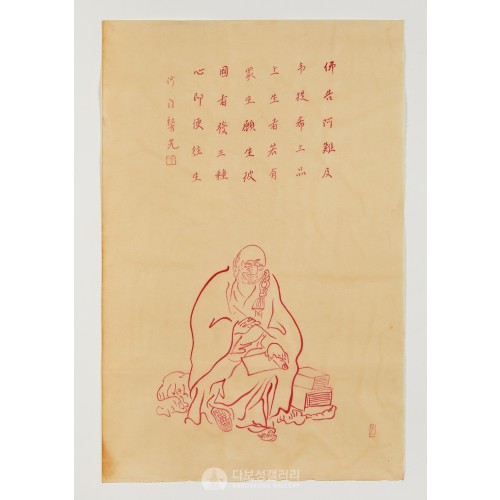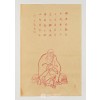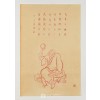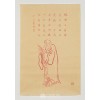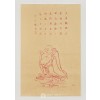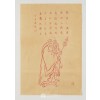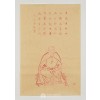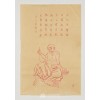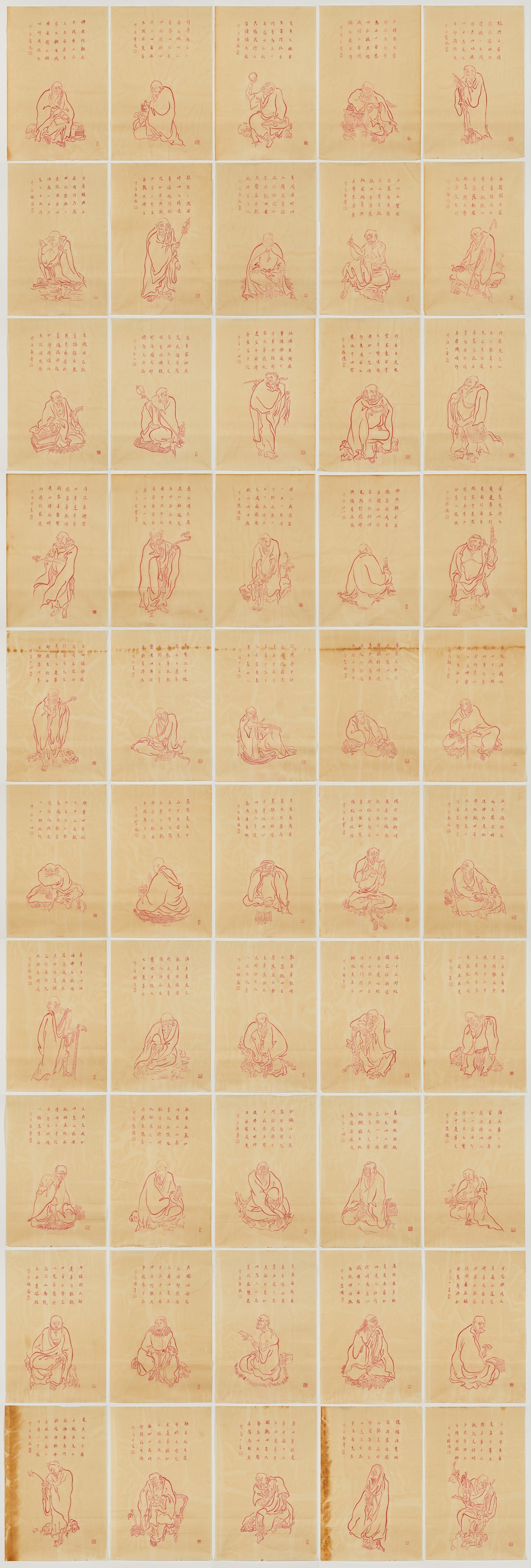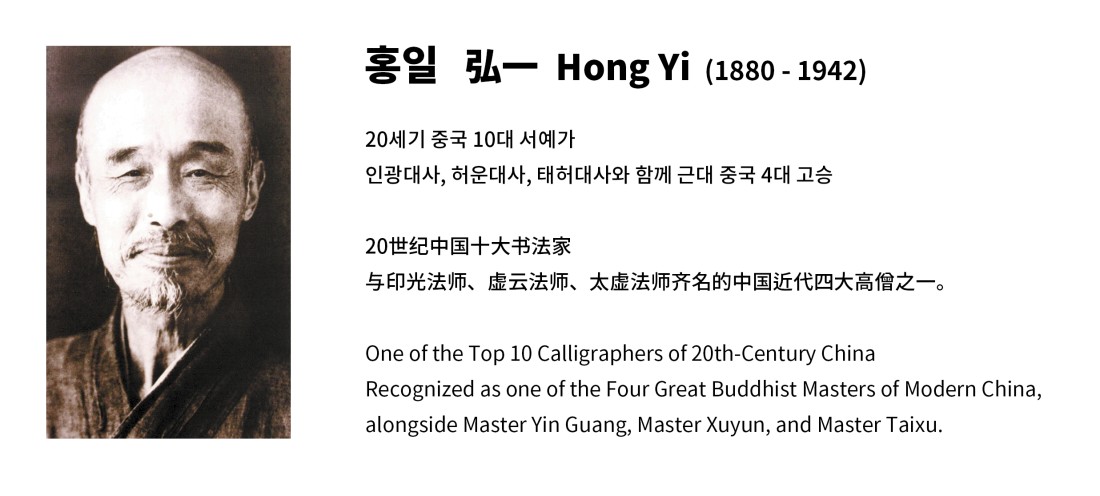본문
이 작품은 홍일법사(弘一法師, 1880~1942)가 《금강반야바라밀경(金剛般若波羅蜜經)》과 《불설관무량수불경(佛說觀無量壽佛經)》을 사경(寫經)하고 그 아래에 나한(羅漢)을 그린 것입니다. 불경마다 50점씩 모두 100점으로 구성된 이 작품은 사경과 나한도를 병치한 독특한 형식입니다.
이 작품에 등장하는 100나한은 석가모니의 가르침을 직접 들은 제자들이자 번뇌를 끊고 열반에 이른 성자들입니다. 특히 동아시아 불교에서 나한도는 주로 18나한, 108나한, 500나한 등으로 형상화되며, 승려 화가들이 수행의 의미로 자주 그렸습니다.
화면은 황색의 얇은 종이 위에 붉은 주사(朱沙) 선묘(線描)로 나한을 묘사하고 있습니다. 상단에는 불경 일부가 정갈하게 적혀 있습니다. 이 작품은 상하구성을 유지하면서도 나한의 자세, 표정, 그리고 경문의 조합을 달리하며 하나하나가 독립적인 불화이기도 합니다.
한 화면에 사경과 나한을 함께 보여주는 구성은 불교 교리의 시각화를 의도한 것으로 보입니다. 또한, 각기 다른 모습의 나한도는 홍일법사의 예술성과 신앙심이 나타난 보기 드문 작품입니다.
▣ 관(무량수)경
《관경》은 《불설관무량수불경(佛說觀無量壽佛經)》을 줄여 부르는 명칭입니다. 이 경전은 아미타불의 서방정토(西方淨土)를 중심으로 하는 정토신앙(淨土信仰)의 주요 경전으로 여겨집니다. 특히 극락왕생을 기원하는 재(齋) 의식이나 의례에서 중심 경전으로 활용되고 있습니다.
이 경전은 중국 후한 시대의 승려 강마등(康僧鎧)이 한역(漢譯)한 것으로 알려져 있습니다. 중국 불교와 동아시아 불교권에서 정토신앙의 핵심 경전으로 널리 받아들여졌습니다. 이 경전은 마가달국(摩竭陀國)의 위제희부인(韋提希夫人)이 옥에 갇히며 석가모니불에게 구제를 요청하는 장면에서 시작됩니다. 주된 내용은 석가모니불이 아미타불의 극락세계(極樂世界)를 관상(觀想)하는 열여섯 가지 관법(觀法)을 설하는 것입니다.
《관무량수경》의 주요 교리는 염불(念佛) 수행을 통한 극락왕생입니다. 특히 죄업이 깊은 중생이라도 진심으로 참회하고 아미타불을 염하면 극락에 태어날 수 있다는 구절은 불교의 대중화에 기여했습니다. 이에 따라 불교에서 전통적으로 강조된 수행 위주의 해탈보다는 아미타불의 힘에 의지한 구제를 강조하는 특징을 가집니다.
▣ 홍일법사 (弘一法師) (1880~1942)
1880년, 중국 톈진에서 관공서 일을 맡던 거상(鉅賈)의 집안에서 태어났습니다.
22세에 상하이 남양공학에 입학하였고, 26세에 일본으로 유학을 떠났으며, 32세에 중국으로 돌아와 톈진공업대학에서 교직을 맡았습니다.
1916년에는 항저우 서호에 있는 정혜사(虎跑定慧寺)에 들어갔고, 1918년(39세)에 출가하여 승려가 되었습니다.
법명은 인음(寅音), 법호는 홍일(弘一)이며, 속명은 이숙동(李叔同)으로 알려져 있습니다.
그는 중국에서 최초로 서양 회화를 도입한 인물이며, 처음으로 오선지를 사용해 음악 교육을 실시한 사람입니다.
또한, 중국 최초의 화극사를 설립하는 등 예술 분야에서 선구적인 역할을 했습니다. 음악, 서예, 회화, 희극 등 다양한 방면에 깊은 조예를 지녔으며, 63년의 생애 중 50년 이상을 서예와 함께했습니다.
현대 서예가들 중에서도 그만큼 열정적으로 서예의 길을 걸었던 이는 드물며, 말년에는 자신만의 독창적인 서체를 남겼습니다.
그의 작품은 중국 서예 예술사에서 탁월한 성과로 평가받고 있습니다.
그는 모든 사람에게 '홍일 스승'으로 알려졌으며, 1942년에 복건성 천주시에서 61세의 나이로 평화롭게 세상을 떠났습니다. 홍일법사는 청나라 말기의 3대 시적 스님(시승 詩僧, 시에 능한 승려) 중 한 명입니다. (다른 사람들은 수만수, 시정간입니다)
━━━━━
本作品由弘一法师(1880~1942年)书写《金刚般若波罗蜜经》与《佛说观无量寿佛经》,并在经文下方绘制罗汉图。每部经典各50幅,共计100幅,形成了一组将书经与罗汉图并置的独特形式。
画中出现的一百位罗汉,是释迦牟尼亲授教法的弟子,同时也是断除烦恼、证得涅槃的圣者。在东亚佛教传统中,罗汉图常以十八罗汉、一百零八罗汉、五百罗汉等形式呈现,常由僧侣画家作为修行的一部分进行描绘。
整组画作以黄色薄纸为底,以朱砂细线描绘罗汉形象,上方则工整书写部分经文。每一幅画在保持整体上下结构统一的同时,通过罗汉的姿态、表情及与经文的搭配变化,使每幅皆具独立的佛画价值。
将书写经文与绘制罗汉合为一体的构图方式,展现了佛教教义的视觉化意图。而每位罗汉不同的面貌与神态,更体现出弘一法师深厚的艺术修养与虔诚的信仰,是极为罕见的佛教艺术作品。
▣ 观(无量寿)经
《观经》是《佛说观无量寿佛经》的简称,是以阿弥陀佛的西方净土为核心的净土信仰的重要经典。该经在祈愿往生极乐世界的法会或佛教仪式中,常作为中心经典广泛诵读。
据记载,本经由中国东汉时期的高僧康僧铠翻译成汉文,在中国佛教及东亚佛教圈中,被视为净土宗的核心经典之一。经文从摩竭陀国的韦提希夫人被囚禁而向释迦牟尼佛求救的情节展开,佛陀随后讲授了观想阿弥陀佛极乐世界的十六种观法。
《观无量寿经》的主要教义是通过念佛修行达到往生极乐的目的。尤其强调,即便罪业深重的众生,只要真诚忏悔、念佛称名,也能得生极乐。这一思想推动了佛教的大众化传播,也体现了不同于以个人修行为核心的传统佛教,更加强调依靠阿弥陀佛慈悲愿力的救度。
▣ 弘一法師 (1880~1942)
1880年出生于天津一官宦富商之家。
22岁时,他进入上海南洋公学学习,26岁时赴日本留学,32岁时回国并在天津工业大学任教。
1916年,他进入杭州西湖附近的虎跑寺,并于1918年(39岁)出家,成为一名僧侣。
法名演音,号弘一,俗名李叔同。
他是中国最早引入西洋绘画的人,也是首位使用五线谱进行音乐教学的人。
此外,他还在中国创办了第一所话剧学校等,成为艺术领域的开创者之一。
他在音乐、书法、绘画、戏剧等多个领域都有深厚的造诣,并且在63年的生命中,有超过50年都在致力于书法。
即使在现代书法家中,像这样充满热情地走上书法之路的人也极为罕见,他在晚年创作了自己独特的书法风格。
他的作品被认为是中国书法艺术史上的杰出成就。
被人尊称为“弘一法师”,于1942年在福建省泉州市以61岁高龄安详圆寂。弘一法师是清末三大诗僧之一(另两位是苏曼殊、释敬安)。
━━━━━
This work was created by the Buddhist monk and artist Hong Yi (弘一法師, 1880–1942), who transcribed the Diamond Sutra (金剛般若波羅蜜經) and the Buddha’s Teaching on the Visualization of the Infinite Life Buddha (佛說觀無量壽佛經), and then illustrated arhats (羅漢) beneath each passage. Composed of 100 pieces—50 from each sutra—this work is characterized by its unique format of pairing sutra transcription with arhat imagery.
The 100 arhats featured in this series are disciples who directly heard the teachings of Shakyamuni Buddha and attained nirvana through the cessation of worldly desires. In East Asian Buddhism, arhats are commonly depicted in groupings such as 18, 108, or 500 figures, and were frequently painted by monk-artists as expressions of spiritual discipline.
Each piece shows an arhat drawn in red cinnabar lines on thin yellow paper. At the top, a portion of the sutra is neatly written. Though the overall vertical structure is consistent, each image stands as an independent Buddhist painting, varying in the arhat’s posture, expression, and the accompanying text.
This pairing of scripture and arhat imagery appears to be an attempt to visualize Buddhist doctrine. Moreover, the diverse portrayals of the arhats reveal Hong Yi’s artistic talent and devout faith, making this a rare and notable work.
▣ The Visualization Sutra (佛說觀無量壽佛經)
Visualization Sutra is an abbreviated name for The Buddha’s Teaching on the Visualization of the Infinite Life Buddha (佛說觀無量壽佛經). This text is one of the central scriptures of Pure Land Buddhism, which is centered on Amitābha Buddha’s Western Pure Land (西方淨土). It is especially used in rites and ceremonies dedicated to prayers for rebirth in the Pure Land.
The sutra is believed to have been translated into Chinese by the Eastern Han dynasty monk Kalayāna (康僧鎧). It was widely accepted in Chinese Buddhism and throughout East Asia as a core scripture of Pure Land belief. The sutra begins with the story of Queen Vaidehī (韋提希夫人) of the Magadha Kingdom (摩竭陀國), who, while imprisoned, seeks salvation from Shakyamuni Buddha. The main content describes sixteen contemplative practices (觀法) taught by the Buddha for visualizing the Pure Land of Amitābha.
The key doctrine of the Visualization Sutra is rebirth in the Pure Land through the practice of nembutsu (念佛), or the recitation of Amitābha’s name. A notable teaching is that even those burdened with deep karmic sins can be born into the Pure Land through sincere repentance and mindfulness of Amitābha, which helped broaden the appeal of Buddhism among the masses. Unlike the traditional emphasis on personal cultivation for liberation, this sutra highlights salvation through reliance on Amitābha’s power.
▣ Hong Yi Dharma Master (弘一法師) (1880~1942)
Hong Yi Dharma Master was born in 1880 into a wealthy merchant family engaged in government affairs in Tianjin, China.
At the age of 22, he entered Nanyang Public School in Shanghai.
At 26, he went to Japan for further studies, and at 32, he returned to China to take a teaching position at Tianjin Industrial University.
In 1916, he entered Dinghui Temple (虎跑定慧寺) at West Lake in Hangzhou.
In 1918, at the age of 39, he became a monk and was given the Dharma name Yin Yin (寅音), with the monastic title Hong Yi (弘一). His birth name was Li Shutong (李叔同).
He was the first person to introduce Western painting to China and the first to use staff notation in music education.
Additionally, he established the first modern Chinese drama society, making significant contributions to the arts.
He excelled in various fields, including music, calligraphy, painting, and theater. Throughout his 63-year life, he devoted more than 50 years to calligraphy.
Few modern calligraphers have pursued the art as diligently as he did.
In his later years, he developed a unique and original calligraphic style, which is regarded as an outstanding achievement in the history of Chinese calligraphy.
He was known to everyone as "Master Hong Yi" and peacefully passed away in 1942 in Quanzhou, Fujian Province, at the age of 61. Hong Yi Dharma Master is regarded as one of the three great poet-monks of the late Qing Dynasty. (The others are Su Manshu and Shi Jingan.)
